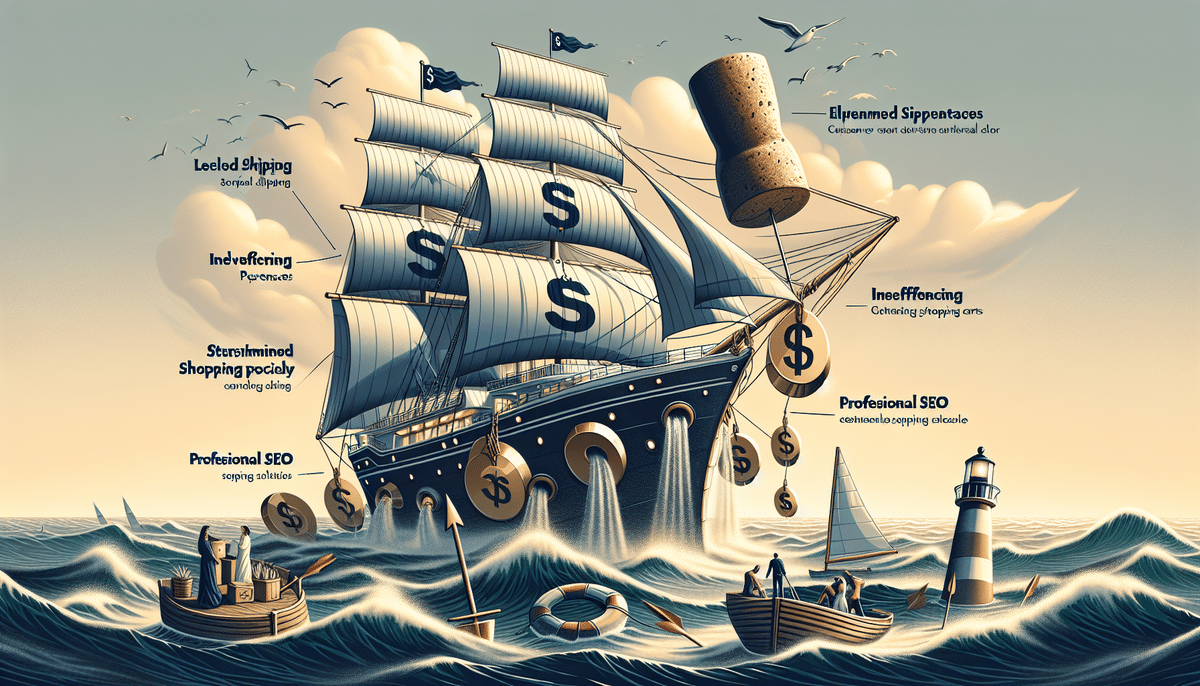How to Stop Your Ecommerce Store from Leaking Money
Running an ecommerce store can be a rewarding venture, but it comes with its own set of challenges. One of the most significant challenges that ecommerce store owners face is identifying and preventing money leakage, which refers to losses from wasted resources, ineffective marketing, and abandoned carts. While it can be challenging to plug these leaks, it is not impossible. In this article, we provide detailed strategies to stop your ecommerce store from leaking money.
Identifying the Sources of Money Leakage in Your Ecommerce Store
The first step in stopping money leaks is to identify the sources of the problem. Money can leak from your ecommerce store through various channels, including:
- High customer acquisition costs
- Wasted resources
- Ineffective marketing strategies
- Abandoned carts
- High product return rates
It's essential to examine each area in detail to understand where the leaks are occurring.
One common source of money leakage is high shipping costs. Customers may abandon their carts if they perceive shipping costs as too high or may opt to purchase from competitors who offer free shipping. To address this, consider offering free shipping for orders over a specific amount or negotiating better shipping rates with your carriers.
Another significant source of leakage is poor customer service. Negative customer experiences can lead to lost sales and a damaged reputation. To prevent this, ensure that your customer service team is well-trained and responsive to inquiries and complaints.
Analyzing Your Ecommerce Sales Funnel to Identify Money Leaks
Analyzing your ecommerce sales funnel is crucial to pinpoint where customers are experiencing friction leading to abandoned carts or lost sales. Start by mapping out your sales funnel from awareness to purchase, then identify drop-off points and analyze the data to understand the reasons behind them.
One common area for leaks is the checkout process. A complicated or lengthy checkout can deter customers from completing their purchases. Simplify the checkout process and clearly communicate any additional fees or charges. Additionally, offering incentives such as free shipping or discounts can encourage customers to finalize their purchases.
The Importance of User Experience in Reducing Money Leaks
User experience (UX) plays a critical role in reducing money leakage. A positive UX increases the likelihood of conversions and repeat purchases. Ensure that your website is easy to navigate, product pages are informative, and the checkout process is seamless.
Website speed is another vital aspect of UX. According to Smashing Magazine, even a one-second delay in page load time can reduce customer satisfaction by 16%. Optimize your website for speed by compressing images, minimizing code, and using a reliable hosting service.
Providing excellent customer service further enhances UX. Make it easy for customers to contact you with questions or concerns and respond promptly and professionally. Quick resolution of issues prevents customers from seeking alternatives and fosters loyalty.
Optimizing Your Ecommerce Website for Better Conversion Rates
Optimizing your ecommerce website is essential for improving conversion rates and reducing money leakage. Key strategies include:
- Improving website loading speed: Fast-loading websites enhance user experience and reduce bounce rates.
- Ensuring mobile-friendliness: With over 50% of ecommerce traffic coming from mobile devices, a responsive design is crucial.
- SEO optimization: Optimize product pages with relevant keywords to increase visibility on search engines.
A seamless checkout process is also vital. Minimize the number of steps required to complete a purchase, offer multiple payment options, and ensure the checkout page is user-friendly. Complicated checkout processes can lead to cart abandonment and lost sales.
Personalized recommendations and promotions can further boost conversion rates. Analyzing customer data and behavior allows you to suggest products that align with their interests and needs, increasing the likelihood of a purchase and enhancing customer satisfaction and loyalty.
Streamlining Your Checkout Process to Prevent Abandoned Carts
A complicated checkout process can deter customers from completing their purchases. Streamlining the checkout involves:
- Ensuring the process is easy to navigate.
- Optimizing the checkout for mobile devices.
- Implementing a guest checkout option to allow purchases without account creation.
Offering multiple payment options is also crucial. Customers prefer different payment methods, and providing options like credit cards, PayPal, and Apple Pay can increase the likelihood of successful checkouts. Additionally, clearly display any additional fees or taxes to prevent unexpected costs from causing cart abandonment.
Reducing Cart Abandonment with Effective Email Follow-ups and Reminders
One of the most effective strategies to reduce cart abandonment is through effective email follow-ups and reminders. Implement reminder emails to customers who have left items in their carts, offering incentives like discounts to encourage completion of their purchases.
Additionally, an email series that keeps customers informed about sales, new products, and promotions can encourage them to return to your store. Simplifying the checkout process further supports these efforts by making it easier for customers to finalize their purchases.
Creating Effective Product Pages That Convert Visitors Into Buyers
Product pages are pivotal in converting visitors into buyers. To optimize product pages:
- Use high-quality product images and videos to showcase your products effectively.
- Provide clear and detailed product descriptions that highlight key features and benefits.
- Display customer reviews and ratings to build trust and credibility.
Employing persuasive language that speaks directly to your target audience can further enhance conversions. Focus on the benefits of your product rather than just features, and avoid technical jargon that might confuse potential customers.
Offering Discounts and Incentives to Encourage Conversion and Repeat Customers
Discounts and incentives are powerful tools to encourage conversions and foster repeat business. Strategies include:
- Offering new customers a discount on their first purchase.
- Implementing a loyalty program to reward repeat customers.
- Providing personalized discounts based on purchase history through targeted email campaigns or social media ads.
While discounts can drive sales, it's important to use them strategically to maintain profitability and avoid creating a customer base that only purchases during sales or promotions.
Implementing Effective Shipping and Delivery Strategies to Reduce Returns
High product return rates can significantly impact your bottom line. Effective shipping and delivery strategies to reduce returns include:
- Offering various shipping options and free shipping for orders above a certain amount.
- Partnering with reliable shipping carriers known for timely and safe deliveries.
- Providing shipping tracking information to keep customers informed about their orders.
- Ensuring products are well-packaged to arrive in good condition.
Additionally, a clear and customer-focused returns policy builds trust and reduces disputes, further lowering return rates.
Leveraging Data Analytics Tools to Monitor and Improve Your Ecommerce Performance
Utilizing data analytics tools is essential for monitoring and improving your ecommerce store's performance. Key actions include:
- Tracking website traffic to understand visitor behavior.
- Analyzing conversion rates to identify areas for improvement.
- Monitoring sales data to gauge the effectiveness of marketing campaigns.
Regular analysis of this data helps in making informed decisions and identifying opportunities to enhance your store's performance.
Creating a Customer-Focused Returns Policy to Build Trust and Loyalty
A customer-focused returns policy is crucial for building trust and loyalty. Ensure that your returns policy is clear, easy to understand, and fair. Consider offering free returns or exchanges to differentiate your store from competitors and lower barriers to purchase.
Building a Strong Brand Image to Increase Customer Confidence and Sales
A strong brand image enhances customer confidence and drives sales. To build a robust brand image:
- Maintain consistency across your website, social media, and other marketing channels.
- Engage with customers through email marketing, social media, and community-building initiatives.
- Highlight your unique value propositions to differentiate your store from competitors.
Building strong relationships with customers fosters loyalty and encourages repeat business.
Investing in Professional SEO Services to Drive More Traffic and Sales
Professional SEO services can significantly boost traffic and sales to your ecommerce store. Key strategies include:
- Optimizing your website for search engines to increase visibility.
- Creating well-written and informative product pages with relevant keywords.
- Implementing a content marketing strategy to drive traffic and establish your brand's authority.
By investing in SEO, you can expand your reach and attract more potential customers to your store.
Conclusion: Taking Action Steps to Stop Leaking Money in Your Ecommerce Store
Stopping money leakage in your ecommerce store requires a strategic approach across various areas. By regularly analyzing your sales funnel, optimizing your website for better conversion rates, enhancing user experience, and building a strong brand image, you can significantly improve your store's performance. Implementing these strategies will help reduce money leaks and drive more sales, ensuring the long-term success of your ecommerce business.




















